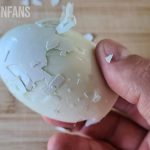Meat Spots in Eggs
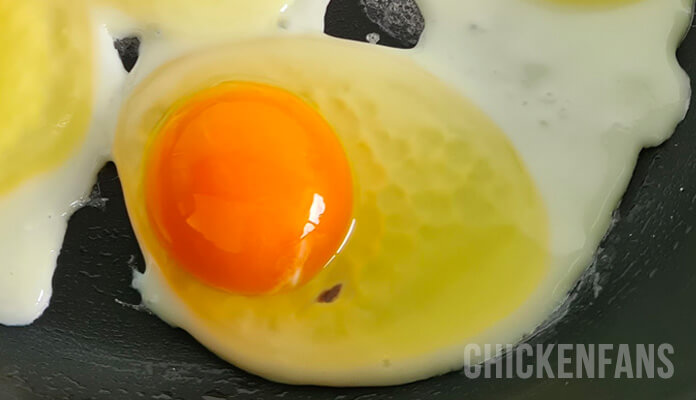
If you regularly crack an egg, you’ve probably noticed meat spots once in a while: tiny brown pieces floating around in the egg whites. Although safe to eat, they don’t look that appetizing.
Let’s have a closer look at those tiny brown spots and how they end up in our eggs.
- What are Meat Spots in Eggs?
- How do Meat Spots end up in the Egg?
- Is it safe to eat Eggs with Meat Spots?
- How frequently do meat spots appear?
- How to prevent Meat Spots
- Meat Spots vs. Blood Spots
- Summary
What are Meat Spots in Eggs?
Meat spots are tiny brown pieces in the egg white. They come from tissue torn from the inside surface of the oviduct when the egg is formed. Meat spots are browner than red blood spots but are safe to eat and have no particular taste.
How do Meat Spots end up in the Egg?
When the ovary releases an egg yolk, it starts its journey through the oviduct to become an egg. It takes about 24 hours for an egg yolk to pass through the entire oviduct before it can be laid. When the yolks pass the magnum, the egg white is formed as a couple of layers of albumen around the yolk.
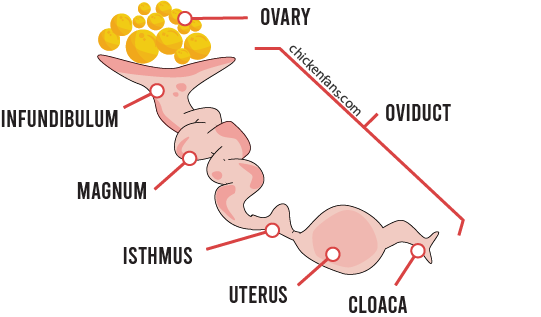
The inside surface of the reproductive tract is very active. All the time, nutrients pass the magnum’s surface to build up proteins for the albumen. The reproductive organs have a special inside layer covered with oviduct epithelial cells to allow for this activity. The oviduct epithelial cells protect, absorb, and excrete biochemical compounds in the oviduct.
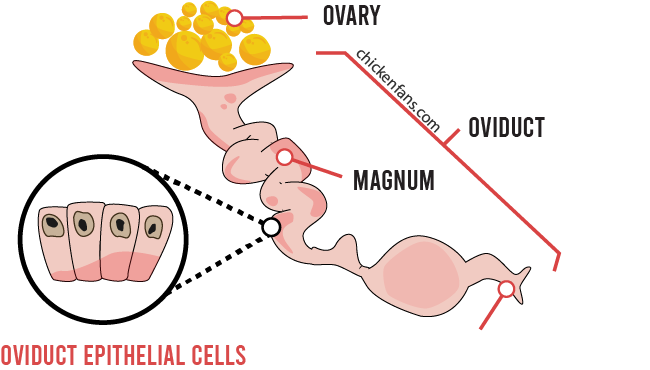
The epithelial cells are continuously renewed, layer by layer. With all the activity and bacteria like Salmonella in the oviduct, sometimes the epithelial cells get damaged, and parts of the inner linings need to be replaced.
The chicken’s body rejects the damaged body tissue, which is torn from the oviduct’s surface to replace it with new, healthy tissue. There is only one way out for the tissue to leave the chicken’s body, via the cloaca.
When an egg passes, it picks up the brown tissue. The tissue ends up in the egg white, which ultimately results in the meat spots you see when you crack the egg.
Is it safe to eat Eggs with Meat Spots?
Yes, it’s safe to eat meat spots in a chicken egg as it’s just small parts of the body tissue of the chicken’s internal lining. It does not change the taste of the egg. You can remove the spot with a spoon if eating doesn’t look appealing.
The USDA publishes quality standards for commercial eggs. Article 56.203B in the United States Standards, Grades, and Weight Classes for Shell Eggs (AMS56) specifies that small meat spots (aggregating not more than 1/8inch in diameter) may be present. Bigger meat spots are considered quality defects that do not render the egg inedible. The same holds for blood spots in the egg.
How frequently do meat spots appear?
The incidence level of meat spots is usually between 2 to 4 percent in commercial-grade eggs, where the bigger meat spots won’t always pass quality control. However, it can range from near zero to 30% of all produced eggs in a flock of backyard chickens. The occurrence varies with the chicken’s age, breed, and strain.
Eggs for the grocery store are candled with bright light to filter out the eggs with meat spots. Candling is challenging for (dark) brown eggs, so the incidence level of meat spots is higher if you get brown eggs from the shelves.
There seems to be a higher incidence of meat spots in chickens compared to ducks, turkeys, and other poultry. It’s unclear if that’s related to genetics rather than the way the birds are managed on big laying farms.
How to prevent Meat Spots
Since meat spots are a normal result of the laying process, it’s impossible to prevent them altogether. The best strategy to avoid meat spots in eggs is to find young pullets known to produce fewer meat spots or other egg irregularities.
To limit the risk of meat spots in the eggs in an existing flock:
- provide your chickens with enough space; use our chicken coop calculator to find out the minimum requirements
- avoid bad confinement conditions, and make sure the coop has proper ventilation
- provide a healthy diet with vitamins and antioxidants
- ensure your chickens don’t suffer from any stress
- cool down your chickens in case they are under any heat stress
However, the older your birds get, the higher the chance for meat spots, regardless of the chicken breed.
Meat Spots vs. Blood Spots
Whereas meat spots are brown spots from torn organ tissue in the oviduct, blood spots result from burst blood vessels in the ovary of a chicken. Fully developed yolks rupture blood vessels from their follicle, which results in blood spots. Both meat spots and blood spots are safe to eat.
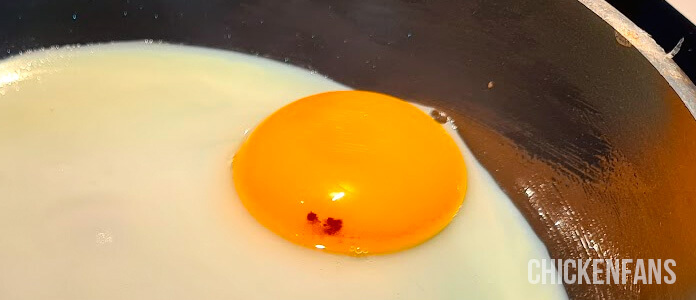
Sometimes blood spots have a brownish color, making them look very similar to meat spots. These are blood spots that are partially broken down and turned brown due to oxidation. Oxygen can enter the egg via the pores in the eggshell. When iron in the egg yolk combines with oxygen, it becomes iron oxide, which has a darker red or brown color, just like rust.
One might think that shedding damaged internal linings also comes with blood. However, there is generally no blood involved since the blood vessels sit far beyond the epithelial cells’ initial layers.
Summary
Meat spots are tiny brown pieces of torn body tissue from a chicken’s oviduct that end up in the egg. They are safe to eat and won’t change the taste of your dishes. While blood spots are more common in the yolk, meat spots usually float in the egg white.
The occurrence varies with a chicken’s breed, age, and health, but it’s next to impossible to prevent meat spots altogether. They occur naturally, and although commercial quality standards reject large meat spots, they won’t render the egg inedible.
Meat spots can resemble blood spots in the egg, especially when the blood spots turn dark brown due to oxidation.




